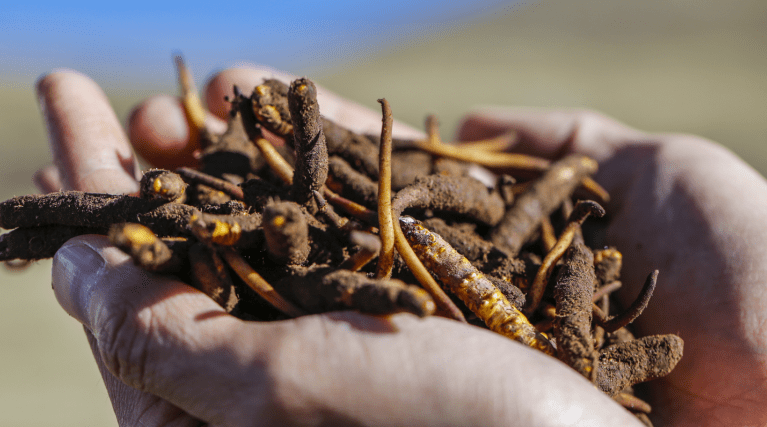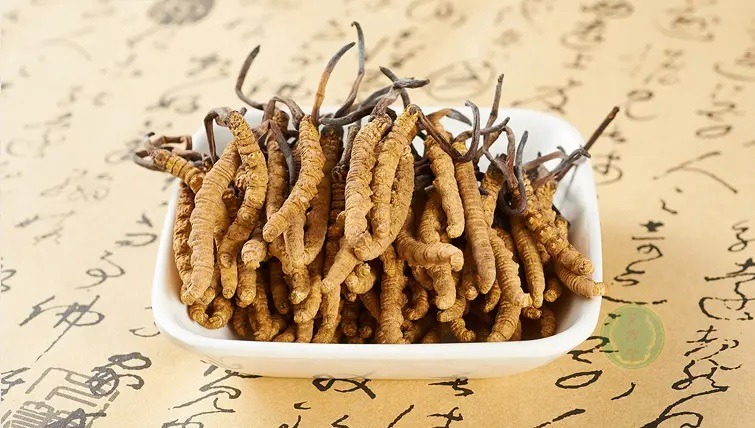The genus Cordyceps contains many chemical compounds and their derivatives in the form of secondary metabolites. Such diverse chemical compounds make them quite intriguing in analyzing therapeutic effects and pharmacological studies. Major chemical compounds such as nucleosides, sterols flavonoids, cyclic peptides, phenolic, bioxanthracenes, polyketides, and alkaloids are found in Cordyceps species.
While in most of the Cordyceps species, cyclic peptides are present in large quantities as compared to other molecules. Besides that, cordycepin and cordycepic acid (CA) are also prominently present in some species of Cordyceps spp. such as C. militaris (L.) Fr.. The presence of cordycepin (3′-deoxyadenosine) and 2′-deoxyadenosine in C. sinensis was characterized by using atomic attractive reverberation (NMR) and infrared spectroscopy (IR).
In addition, a class of saccharides and polysaccharides such as cyclofurans, a cyclic ring of five-carbon sugars, heteropolysaccharides beta-glucans, beta-mannans cross-connected beta-mannan polymers, and complex polysaccharides comprising of both five and six carbon sugars were also discovered from Cordyceps.
 Even though Cordyceps contains a lot of bioactive molecules, it has immunosuppressive compounds, cyclosporine usually found in Cordyceps subsessilis Petch. Besides this, some immunosuppressant compounds were also extracted from the closely related Cordyceps species Isaria sinclairii (Berk.) Lloyd.
Even though Cordyceps contains a lot of bioactive molecules, it has immunosuppressive compounds, cyclosporine usually found in Cordyceps subsessilis Petch. Besides this, some immunosuppressant compounds were also extracted from the closely related Cordyceps species Isaria sinclairii (Berk.) Lloyd.
Cordycepin and Cordycepic Acid
Cordycepin and Cordycepic Acid (CA) are prominently found in C. militaris (L.) Fr. They are important bioactive molecules having potential therapeutic applications. Structurally, cordycepin is 3′-deoxyadenosine, and CA is D-mannitol. Cordycepin is an analog of adenosine derivatives differentiated from adenosine nucleoside by the absence of one oxygen molecule at the third position carbon of ribose sugar.
Cordycepin has been related to various therapeutic ailments, including intracellular targets, nucleic acid, apoptosis, and cell cycle. This diverse role of cordycepins in cellular and molecular activities is due to its resemblance to adenosine. On the other hand, CA is structurally an isomer of quinic acid possessing various potential medicinal applications.
Previously, CA structure was concluded as 1,3,4,5-tetrahydroxycyclohexane-1-carboxylic acid. Later, it was found to be the crystalline substance of D-mannitol. It differs mainly from quinic acid as it forms dextrorotatory instead of lactone.
There is a tremendous variety of CA content in the Cordyceps. However, in C. sinensis, it is usually 7–29%, differing in the growing stages of the Cordyceps. CA greatly influences treating liver fibrosis, diuretic, plasma osmotic pressure, and anti-free radical properties.
Polysaccharides
Cordyceps contains different types of polysaccharide components. The fruiting bodies of Cordyceps consist of 3–8% polysaccharides. It was known that the polysaccharides obtained from Cordyceps species are medicinally important and can play as one of the main constituents in drug formulation.
These polysaccharides can effectively control the blood sugar level in the body, show antimetastatic and antitumor effects, and also have anti-influenza, immunoprotective, and antioxidant effects. Cordyceps polysaccharides represent structurally diverse, biologically active macromolecules of vast physiochemical properties. These polysaccharides are either intracellular or extracellular. Molecular weight greater than 16,000 is shown to have effective antitumor properties.
The polysaccharides derived from edible, medicinal mushrooms showed antitumor and immunomodulating properties, which were firstly reported from the fruit body of Lentinusedodes in 1969. Therefore, many edible and medicinal polysaccharides, including Cordyceps, have been rigorously investigated over the past 30 years. Apart from this, many novel antitumor and immunomodulatory polysaccharides have been developed and commercialized.
The important species of Cordyceps from which polysaccharides have been extracted and developed which possess antitumor activities include C. sinensis, C. cicadae S.Z. Shing, C. ophioglossioides (Tolypocladium ophioglossoides (Ehrh.) Quandt, Kepler & Spatafora), C. militaris (L.) Fr. and C. kyushuensis A. Kawam.
The polysaccharides combined with other chemotherapeutic drugs showed synergism and increased body resistance. Polysaccharides derived from Cordyceps primarily include glucan, mannan, heteroglycan, and glycoprotein but only β-(1→3) glucan, galactosaminoglycan, and proteopolysaccharide from C. cicadae S.Z. Shing, C. ophioglossioides and Cordyceps spp. showed antitumor activity.
Proteins and Nitrogenous Compounds
Cordyceps contains all essential amino acids, proteins, peptides, and polyamines. In addition, the Cordyceps contains several rare cyclic dipeptides, including cyclo-[Gly-Pro], cyclo-[Leu-Pro], cyclo-[Val-Pro], cyclo-[Ala-Leu], and cyclo-[Thr-Leu]. Significant amounts of polyamines, such as 1,3-diamino propane, cadaverine, spermidine, spermine, and putrescine, were also detected. Other nitrogenous compounds like putrescine and putrescine were also identified.
Nucleotides/Nucleotide Derivatives
Besides the other components, Cordyceps is rich in nucleotide and its derivatives. In cordyceps sinensis nucleosides are the main component contributing to therapeutic applications. Nucleosides including adenine, adenosine, inosine, cytidine, cytosine, guanine, uridine, thymidine, uracil, hypoxanthine, and guanosine have been extracted from C. sinensis. Among the nucleotide components, guanosine has the highest content ratio of other ingredients.
There is a usual difference between the nature of nucleosides from that of normal and cultured C. sinensis. Many specific nucleosides that are not found elsewhere can be found in the Cordyceps spp., which includes several distinct deoxyuridin structures, adenosine, 2′-3′-dideoxyadenosine, hydroxyethyladenosine, cordycepin triphosphate, guanidine, and deoxyguanidine. Adenosine and cordycepin (3′-deoxyadenosine) possess multiple functions such as immunomodulatory, antioxidant, etc.
Sterols and Fatty Acid
Fungi contain sterols in the form of ergosterol, an essential part of the great therapeutic important part of vitamin D2. Cordyceps has identified several sterol-type compounds and a few of these names: ergosterol, ergosterol-3, ergosterol peroxide, 3-sitosterol, daucosterol, and campesterol.
In Cordyceps, the existence of ergosterol varies depending on their growth stage, i.e., ergosterol was 1.44 mg/g in Cordyceps spp. mycelium, while 10.68 mg/g in fruit bodies. Some derivatives of Cordyceps spp. are found in D-3-ergosterol, 3-sitosterol, daucosterol, campesterol, and so on. It is important to mention that HPLC in C. sinensis detects ergosterol.
The fatty acids found in Cordyceps can be classified loosely into two fatty acids, saturated and unsaturated.
Cordyceps can compensate for up to 57.84% of unsaturated fatty acids. Fatty acids such as lauric acid, myrtic acid, pentadecanic acid, palmitic acid, linoleic acid, oleic acid, stearic acid, and docosanic acid, are reported in Cordyceps. 28 saturated and unsaturated fatty acids and their derivatives were extracted from C. sinensis along with polar compounds including several alcohols and aldehydes. The unsaturated fatty acids have various physiological activities, including decreased lipid blood and cardiovascular disease.
Other Constituents
In addition to the core ingredients, C. sinensis is made mainly from proteins, peptides, polyamine, both important amino acids, and other unusual cyclic dipeptides such as cyclo-[Gly-Pro-], cyclo-[Leu-Pro-], cyclo-[Val-Pro] and cyclo-[Thr-Leu]. Cyclic dipeptides, including cyclo-(Leu-Pro) and cyclo-(Phe-Pro), were seen to have antimicrobial activity and anti-mutagenic properties in the battle against the production of vancomycin-resistant Enterococcus (VRE) and pathogenic yeasts.
As per the study, cyclic (bacterial) dipeptides inhibit the development of aflatoxin, and protein rates differ greatly in the sum of dead larvae (29.1%) and fruit body (30.4%), and mycelial fermentation (14.8%). The primary amino acids are present in the larvae, such as glutamic acid, aspartic acid, and amino acid. The anti-inflammatory and anti-nociceptive properties of cordymine, a peptide isolated from C. sinensis medicinal mushrooms, have been reported.
The exopolysaccharide fraction (EPSF) is derived from the harvested C. sinensis supernatant. The cultured supernatant has been collected and then processed with the three times in volume of 95% ethanol for precipitation.
Consequently, a large amount of EPSFs was found on the soil. EPSF has a wide spectrum of pharmacologic effects, with immunomodulatory and antitumor effects most important. EPSF has already shown that it can scavenge free radicals, promote the differentiation of cell cancer, and improve the ability of antitumor activity by triggering many immune responses. Ion-exchanging and size chromatography is used to extract polysaccharides (PS) from cultivated C. sinensis mycelia.
Polysaccharide fraction (PSF) has been extracted from C. sinensis fungus and has a relaxing effect on the macrophage. PSF has been shown to transform M2 macrophages to M1 phenotypes by activating the nuclear factor kappa-B (NF-κB) pathway. PSF also has immunomodulatory impacts, including many other polysaccharides. A study to document the effect of C. sinensis on T-lymphocyte subsets of chronic renal failure patients reported that different components of Cordyceps spp. polysaccharides enhanced the cellular immune function, phagocytic function of monocyte-macrophage, and improved renal functions, spleen, and thymus index.


Leave A Comment